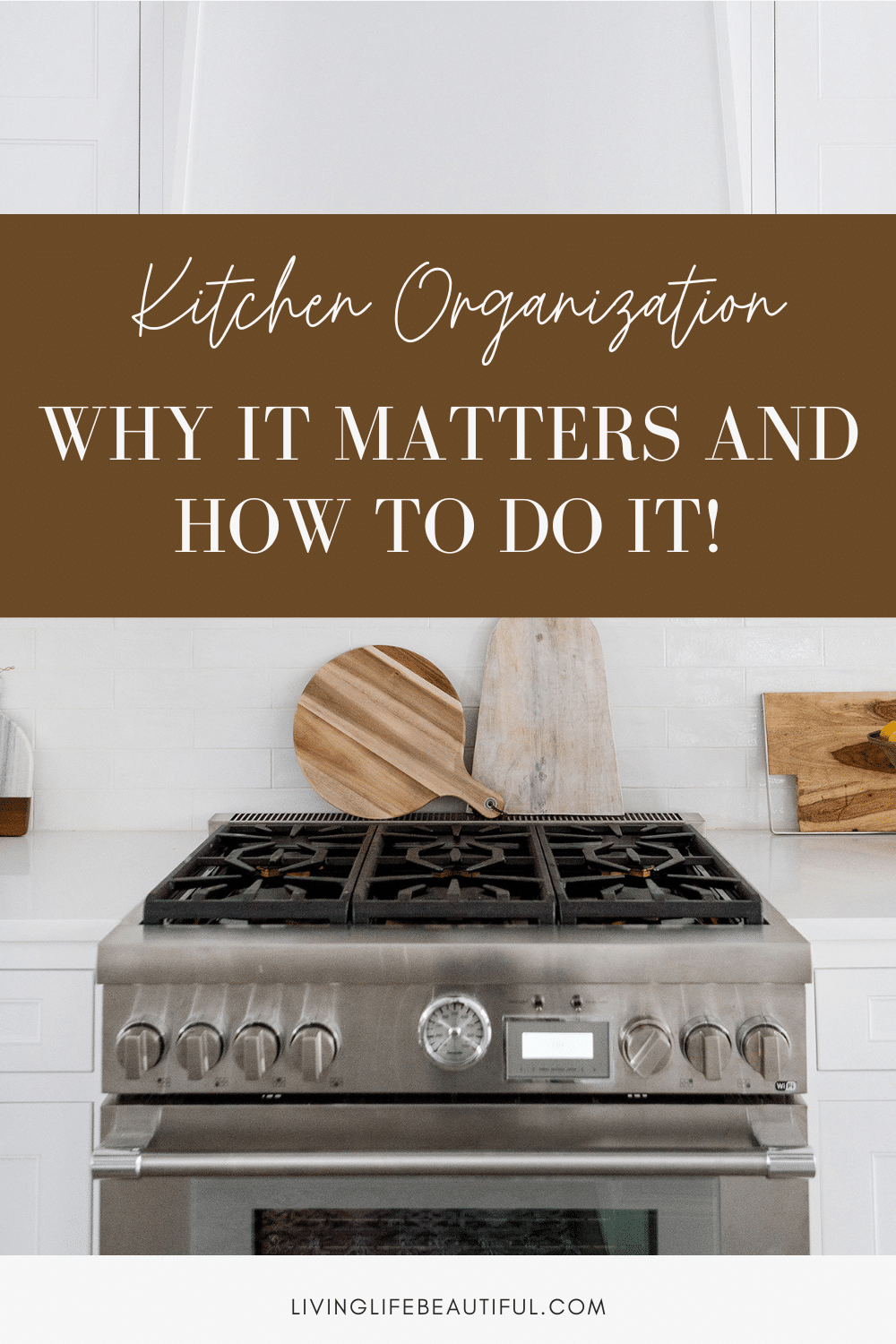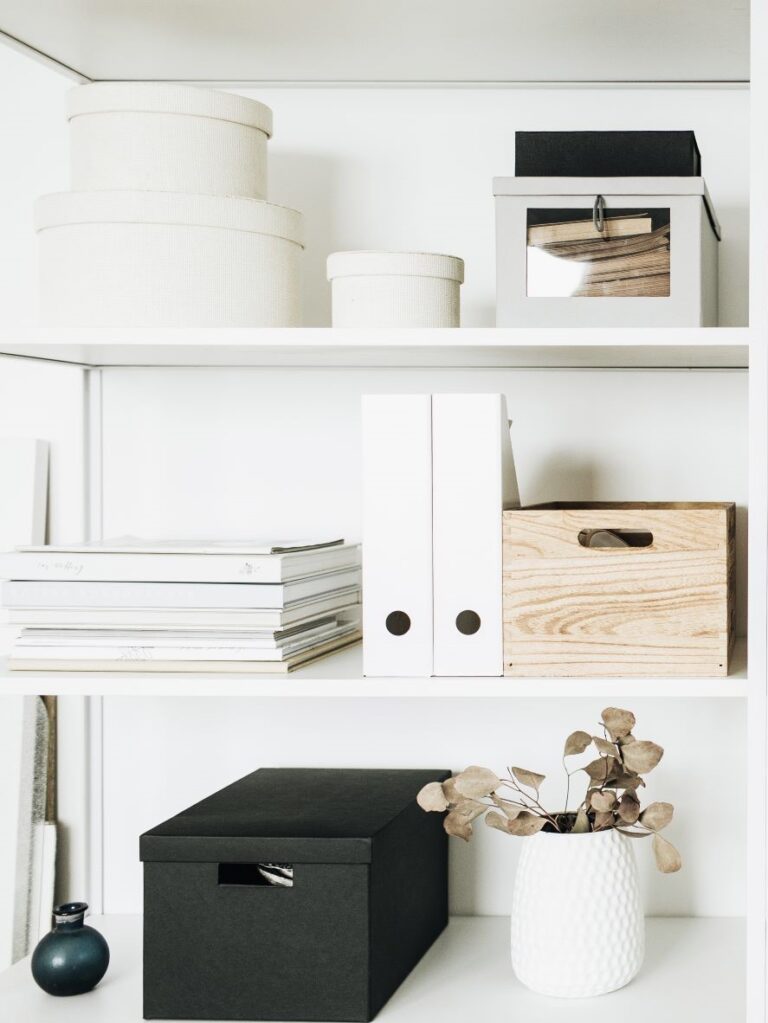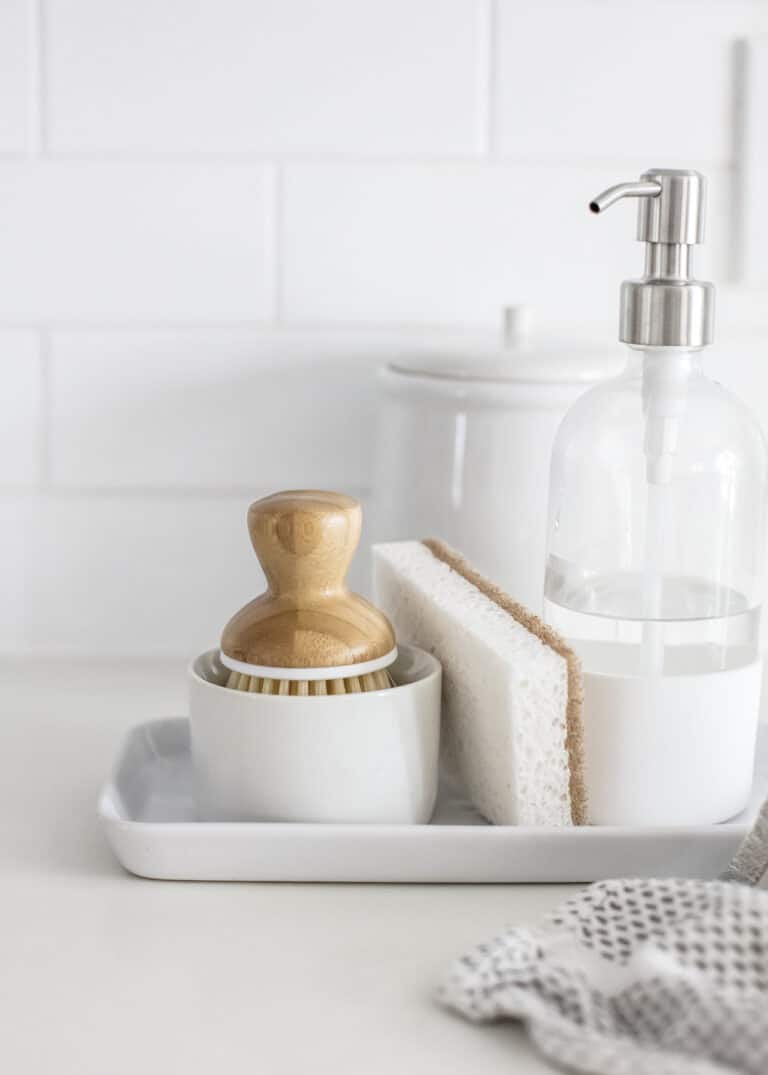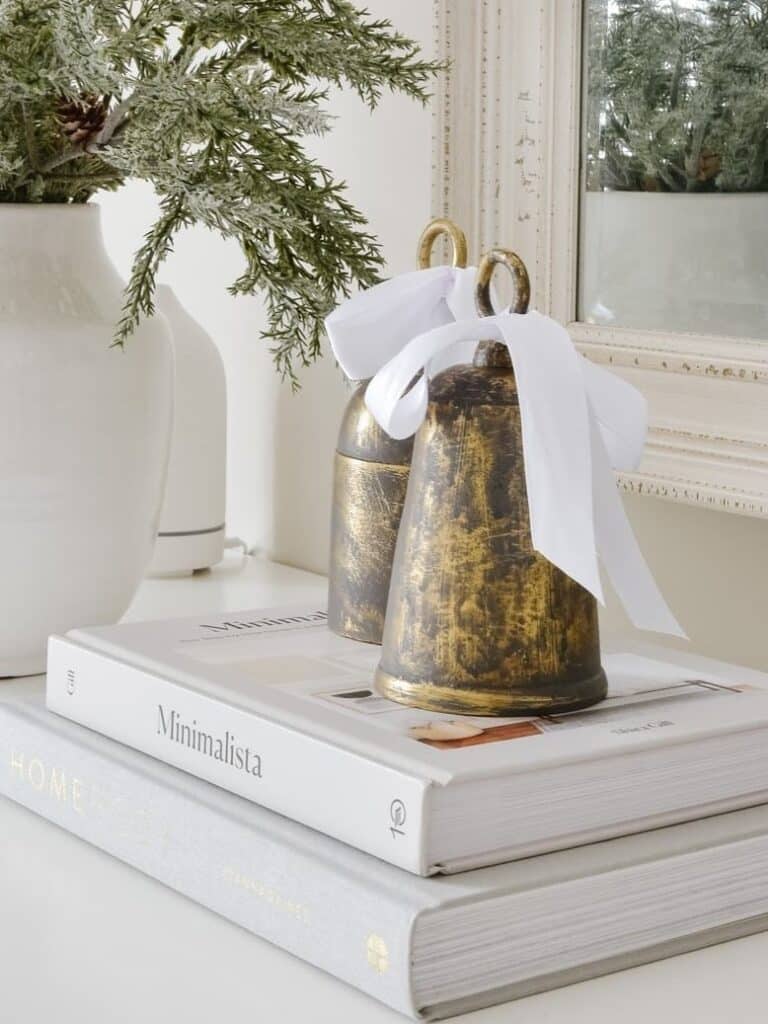Kitchen Organization: Why it Matters & How to Do It
The kitchen is often called the heart of the home, and for good reason! It’s where delicious meals are made, memories are cherished, and daily life happens. But, let’s face it, a disorganized kitchen can turn this special space into a source of stress. Learn why kitchen organization is super important, how to organize a kitchen for efficiency, and how a well-organized kitchen can make cooking more enjoyable and stress-free.
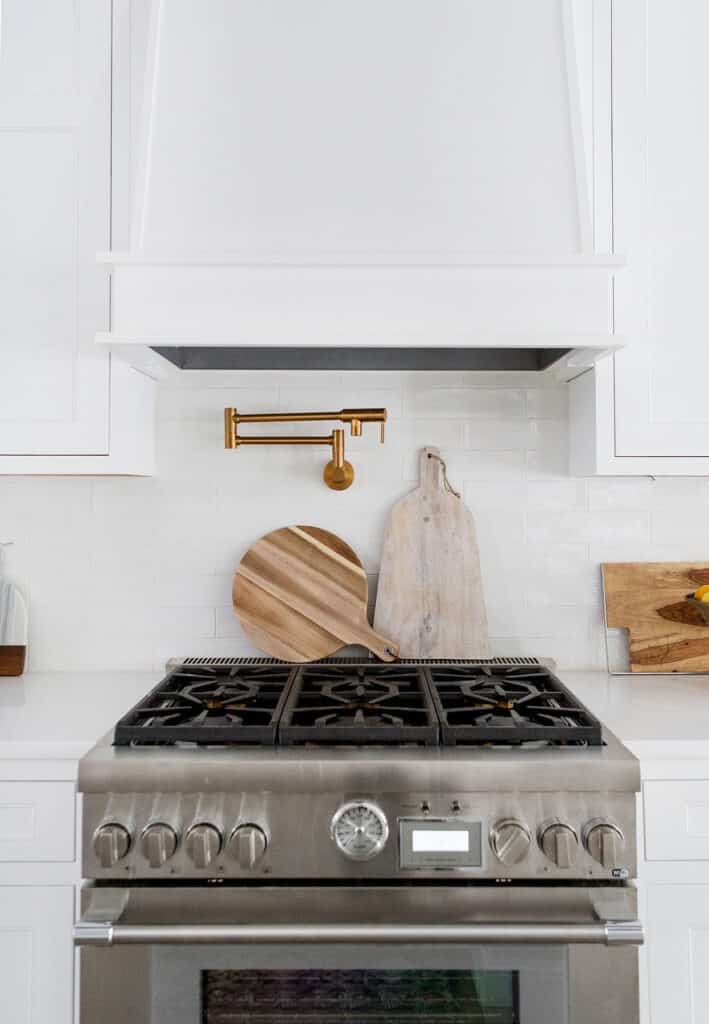
My Organized Kitchen
I have made the most of what I have in every home. In my kitchens, my friends would comment about how my canned goods faced in the same direction and how my glasses were so tidy in my cupboards.
Whether you love your kitchen or not, you can make the most of it with a few simple changes. From a kitchen design outlook, I can’t wait until we tackle this room in our home, but let’s not let the layout of our current kitchen deter us from cooking at home and being grateful for what we have.
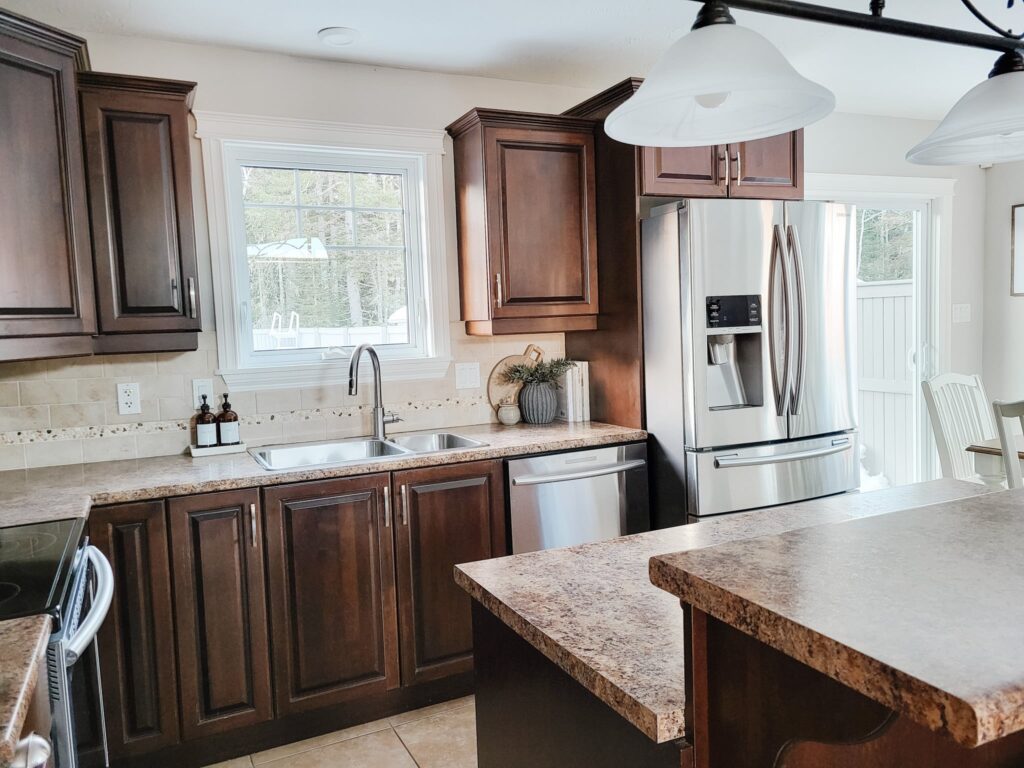
Your kitchen may look different from how you want it to, but you can tackle organizing it one project at a time. I began by organizing my spice drawer; this small change made a big difference, giving me easy access to cooking essentials.
I wrote this guide to help you realize the importance of kitchen organization in your daily life and how to organize a kitchen efficiently. Once your kitchen is organized, you can finally try out all those recipes you’ve collected. So, let’s get started!
Why an Organized Kitchen Leads to Efficient Cooking and Less Stress
1. Enhances Cooking Efficiency
When your kitchen is well-organized, you’ll always know where to find everything, like cooking gadgets, utensils, spices, or pots and pans. This saves you time and lets you focus more on enjoying the cooking process. Plus, with everything in its place, you can quickly move from one task to another, follow your recipe, and avoid making mistakes.
Pro Tip: Group similar items together – keep all your baking tools in one drawer, spices in another, and pots and pans in a designated cabinet. And remember to label containers if needed!
2. Reduces Stress and Anxiety
A cluttered kitchen can be overwhelming, right? It can make even the simplest tasks feel like a burden. Unorganized counters, overflowing kitchen cabinets, and misplaced items can stress you out, especially in a hurry.
On the other hand, a tidy kitchen creates a calming environment and can make cooking much more enjoyable. You can approach food preparation with a clear mind and a positive attitude when everything is in order.
Pro Tip: Start by decluttering your kitchen. You can get rid of items you no longer use or need. Another idea is implementing a weekly maintenance routine to keep things tidy and stress-free.
3. Promotes Healthier Eating Habits
Keeping your kitchen organized can make it easier to eat healthier. When your pantry is tidy and well-stocked, you can spot the ingredients you have, which might inspire you to cook at home instead of ordering takeout.
Plus, if you arrange your fridge and pantry with healthy options at eye level, you’ll be more likely to reach for them when hungry.
Pro Tip: Use clear containers for healthy snacks and ingredients to make them easy to find. Also, arrange your fridge so that fresh produce is right in sight. This makes it more tempting to use before it spoils.
4. Saves Money
Understanding how to organize your kitchen for efficiency can actually help you save money. You will reduce food waste by avoiding duplicate purchases and ensuring that you use what you have effectively.
Pro Tip: Regularly inventory what’s in your pantry, fridge, and freezer, and plan your meals based on what you already have. This will not only minimize waste but also save you money on groceries.
5. Encourages Creativity
When your kitchen is tidy and organized, it can boost your creativity! A clean workspace allows you to focus on experimenting with new recipes, trying different cooking techniques, or simply enjoying the cooking process. It makes cooking more spontaneous and fun, leading to more delicious recipes.
Pro Tip: Keep a notepad or recipe journal in your kitchen to jot down ideas or notes as you cook. Organizing your space for creativity can inspire you to experiment more and have fun in the kitchen!
The Importance of an Organized Kitchen
Invest some time into organizing your kitchen, and you’ll enjoy a more efficient and stress-free cooking experience. Take a moment to assess your kitchen and use the following steps to make small changes today. You’ll gain efficient cooking techniques and boost your overall well-being.
How to Organize a Kitchen for Efficiency: A Step-by-Step Guide
Organizing your kitchen can seem overwhelming, especially if the clutter has been piling up. However, with a clear plan and helpful tips, you can turn your kitchen into a functional, efficient, and stress-free space.
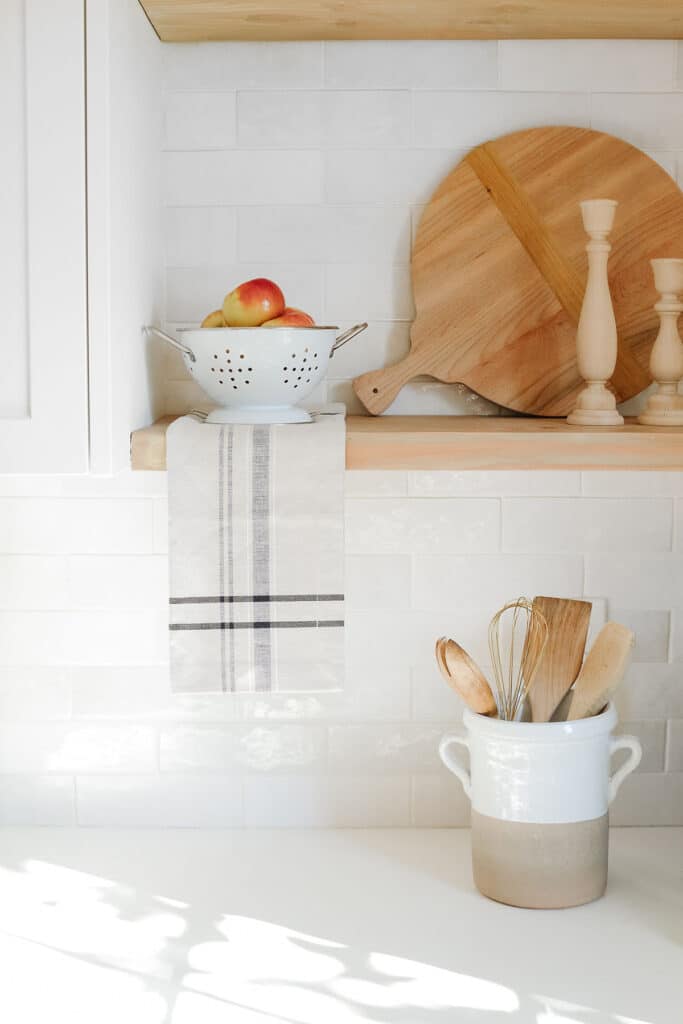
This step-by-step guide will help you declutter and set up your kitchen using my best home organizing tips. Following these steps, you will learn how to organize a kitchen efficiently and maintain it long-term.
Step 1: Assess & Inspect Your Kitchen
Before you start organizing, assess your kitchen and identify problem areas. Are your countertops cluttered? Do you have overflowing cabinets? Understanding the current state of your kitchen will help you focus on the areas that need the most attention.
Pro Tip: List the specific issues you want to address, such as a cluttered countertop, messy spice drawer, disorganized pantry, or overstuffed drawers.
Step 2: Declutter, Deliberate, and Decide
The first step to organizing is decluttering. Go through each kitchen area and remove items you no longer use, need, or love. This includes expired food, duplicate items, old appliances, and other items that take up valuable space.
Pro Tip: Divide your items into categories – keep, donate, sell, or toss. Be ruthless in your decision-making. If you last used something over a year ago, let it go.
Step 3: Clean Your Kitchen
Once everything is cleared out, give your kitchen a thorough clean. Wipe down the cabinets, drawers, countertops, and kitchen appliances to create a fresh starting point for the organization process.
Pro Tip: Use natural cleaning products to clean surfaces where possible. My ultimate guide to natural cleaning products has a complete list of recommendations.
Step 4: Group Similar Items Together
After cleaning and decluttering your kitchen, the next step is to start organizing. Begin by grouping similar items. Keep baking supplies in one area, pots and pans in another, and store all your utensils in a designated drawer. This will make it easier to find what you need when you’re cooking.
Pro Tip: Use drawer dividers, bins, or baskets to keep grouped items neatly contained. For example, store all your baking tools in a clear, easily pulled-out container. For shopping ideas, use my Best Home Organizing and Storage Solutions Guide.
Step 5: Optimize Cabinet and Drawer Space
Try using organizers, shelves, and racks to create more space when organizing your cabinets and drawers. You can also maximize storage with the use of vertical space, like stacking shelves and under-shelf baskets. Remember to arrange items based on how often you use them—keep everyday items easily accessible and store less frequently used items higher up or in harder-to-reach areas.
Pro Tip: Using clear containers or labels will help you keep track of what’s inside cabinets and drawers, saving time and preventing you from forgetting where things are stored.
Related Posts:
- How to Organize Spices in a Drawer Step-by-Step Drawer
- How to Organize Tea Bags: Simple Storage Solutions
Step 6: Create Kitchen Zones
Organizing your kitchen into different zones can improve how you use the space. Try creating specific work areas for tasks, like a cooking zone near the stove, a prep zone on the counter, and a cleaning zone by the sink. This simple system will help you work more efficiently and enjoy cooking even more.
Pro Tip: Store related items together in each zone, such as storing pots and pans near the stove, knives and cutting boards in the prep area, and keeping dish soap and sponges by the kitchen sink.
Step 7: Organize the Pantry and Fridge
Remember to organize your pantry and fridge to help plan meals and reduce food waste. Start by categorizing items—group canned goods together, keep snacks in one area, and store grains and pasta in another. Use clear bins or baskets to contain smaller items, and label everything for easy identification.
Pro Tip: Store frequently used items in your pantry and fridge at eye level. Place older items in front so they’re used first, and keep healthier options within easy reach.
Step 8: Maintain Your Organized Kitchen
Once you’ve learned how to organize a kitchen for efficiency, regular love and care are the keys to keeping it that way. Set aside a little time each week to tidy up, put things back in their proper places, and make any necessary adjustments. Staying on top of it will prevent clutter from piling up again.
Pro Tip: Try to create a routine, like spending 10 minutes each evening to keep your kitchen organized.
Maintaining a Clutter-Free Kitchen: Tips to Keeping Your Kitchen Tidy Over the Long Term
Maintaining a clutter-free kitchen is key to enjoying cooking. It takes effort to keep things organized, but developing good habits and routines can help prevent clutter from piling up again. These practical tips will keep your kitchen stay tidy in the long run so you can enjoy a clean and efficient kitchen for years to come!
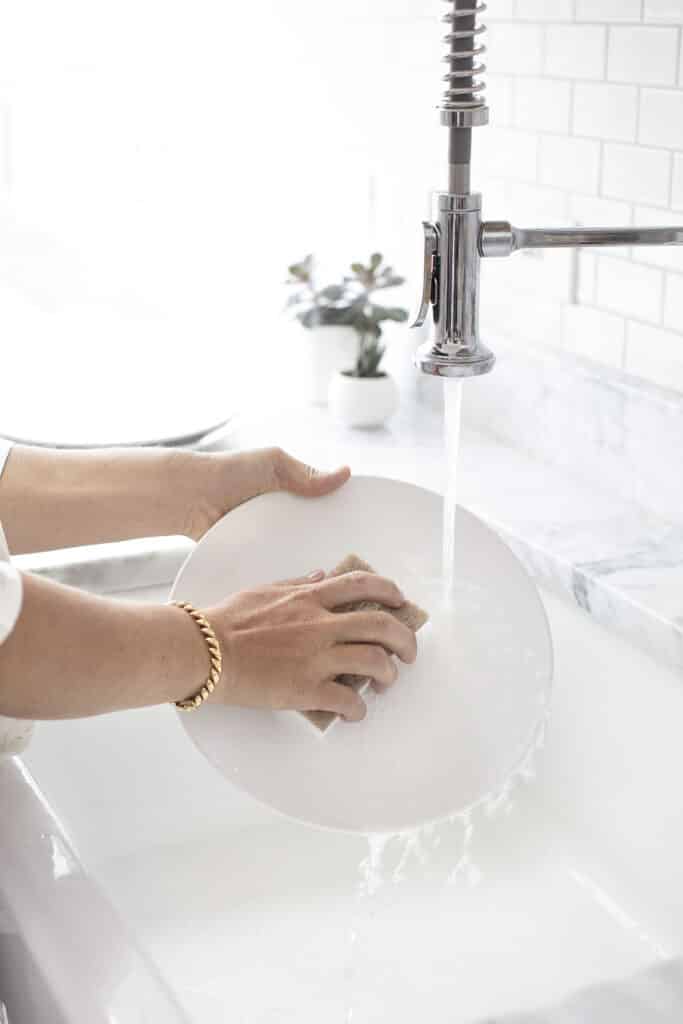
1. Adopt the “Clean as You Go” Mentality
It’s important to maintain a clutter-free kitchen by cleaning as you go. Instead of letting dishes and mess pile up during meal preparation, take a few moments to clean up as you cook.
Pro Tip: Wash cutting boards, utensils, and mixing bowls right after you use them, and wipe down counters as you work. Also, keep a sponge or cloth handy to quickly wipe up spills. This habit will prevent messes from becoming overwhelming.
2. Implement a Daily Reset Routine
At the end of each day, take a few minutes to tidy up your kitchen. Put away any items left on the counters, load or unload the dishwasher, and give everything a quick wipe down. This simple routine will help you start each day with a clean and organized kitchen.
Pro Tip: To make it fun and quick, set a timer for 10-15 minutes and involve your family in sharing the responsibility.
3. Declutter Regularly
Even with the best intentions, clutter can sneak up on you over time. If you want to know how to organize your kitchen for efficiency, try to get into the habit of decluttering your kitchen regularly. Review your drawers, cabinets, and pantry to get rid of items you no longer use or need.
Pro Tip: Plan for a monthly or quarterly decluttering session. Donate or recycle items you no longer need, and make sure everything you decide to keep has its own designated spot.
4. Limit Countertop Items
Keep your countertops free of clutter by keeping only essential items on them, such as a coffee station, a fruit bowl, or a cutting board.
Pro Tip: Store frequently used small appliances in easy-to-reach cabinets or on shelves. If you notice things accumulating on the counter, take a moment to put them back in their proper place.
5. Use Labels and Clear Containers
Using labels and clear containers can help keep things organized. They help everyone in the household find things easily and reduce the chances of items getting lost or forgotten.
Pro Tip: Label your pantry containers, spice jars, and storage bins. Using clear containers for food storage makes it super easy to see what’s inside, which can help prevent buying duplicates or wasting food.
6. Maximize Cabinet and Drawer Space
Organizing your cabinet and kitchen drawers efficiently is the key to keeping your kitchen clutter-free! Use organizers, dividers, and stacking shelves to keep everything tidy and easy to reach.
Pro Tip: Keep your most-used items at the front and the lesser-used ones at the back. Add pull-out shelves or hanging racks to maximize your cabinets if space is tight.
7. Establish a Weekly Deep Clean Routine
In addition to your daily reset, set aside time each week for a more thorough kitchen cleaning. This can include wiping cabinet doors, cleaning the microwave, organizing the fridge, and scrubbing the sink.
Pro Tip: Create a checklist of tasks for your weekly deep clean. Breaking it down into manageable steps makes it easier to stay consistent.
8. Encourage Family Participation
Keeping the kitchen tidy is so much easier when everyone pitches in. Encourage everyone to clean up and put items back where they belong.
Pro Tip: Give family members different tasks like unloading the dishwasher, taking out the trash, or wiping down counters. This way, everyone can help keep the kitchen organized and clean!
9. Don’t Let the Mail and Paper Pile Up
Are you dealing with paper clutter in the kitchen? Mail, receipts, and school papers can pile up. Try a special spot for all things paper, like a cute wall-mounted organizer or a bin.
Pro Tip: Make it a daily habit to sift through mail and papers. Recycle or shred what you don’t need, and file away important documents right away.
Always remember that maintaining a clutter-free kitchen is an ongoing process. With the right habits and routines, it can become second nature. Following these tips will create a tidy, efficient kitchen that enhances the joy of cooking and daily life. Remember, consistency is key—small, regular efforts will keep your kitchen in shape over the long term.
Kitchen Organization and Maximum Efficiency
Organizing a kitchen for efficiency doesn’t have to be overwhelming. By following these how-to steps, you can create a functional and enjoyable kitchen. Remember, the goal is to make your kitchen work for you and your personal style, so feel free to customize these tips to suit your needs.
Once you have your kitchen organized, you can easily make quick & healthy recipes at home and enjoy more family time!
Have you recently organized your kitchen? What tips and tricks have worked for you? Share your experiences in the comments below!
check out some of my family recipes

Hey there, I’m Cheryl
I’m a proud mom, wife, business professional, and Maritimer who loves decorating and organization. From daily essentials to interior design, join me as I share my next project, plan, or tutorial. Using simple planning and organization strategies, I love to help folks like you bring more beauty and harmony into your lives and living spaces.
Feeling overwhelmed or short on time? Decluttering and organizing your home can lead to a more calm, efficient environment that frees up both time and energy. Dive into these step-by-step guides to create a balanced and harmonious space that truly supports your lifestyle. Let’s keep organizing simple and transformative!
Don’t forget to pin this for later!
